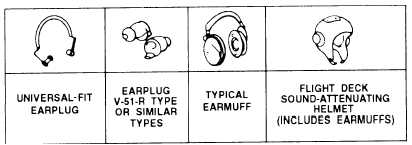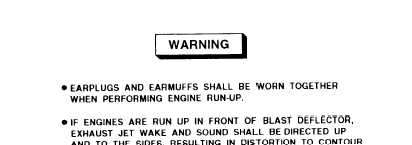| |
Figure 8-3.—Ear-protective devices.
Exhaust Area Hazards
Jet engine exhaust creates several hazards. Tests
show that while the carbon monoxide content of jet
exhaust is low, other gases are present that are imitating
to the eyes. Less noticeable, but as important, is the
respiratory irritation exhaust fumes may cause.
The two most important hazards of jet engine
exhaust are the high temperature and high velocity of
the exhaust gases from the tail pipe. You can find high
temperatures up to several hundred feet from the tail
pipe, depending on wind conditions. Closer to the
aircraft, temperatures are high enough to damage
asphalt pavement.
When a jet engine is started, excess fuel
accumulates in the tail pipe. When the fuel ignites, long
flames can be blown out the tail pipe. Flight line
personnel should know the possibility of this hazard.
They should keep all flammable materials clear of the
danger area.
During maximum power settings, the high velocity
of the exhaust gases may pick up and blow loose dirt,
sizable rocks, sand, and debris several hundred feet.
that creates an eye and FOD hazard. Therefore, you
should use caution when parking an aircraft for run-up.
The general information section of the applicable
maintenance instruction manual (MIM) contains
information about exhaust area hazards. These
instructions should be strictly adhered to. NO ONE
SHOULD FOOLISHLY EXPERIMENT WITH
THE SPECIFIED SAFETY MARGINS.
After engine operation, no work should be done to
the exhaust section for at LEAST ONE-HALF HOUR
(preferably longer). If work is required immediately,
personnel must wear heat-resistant gloves.
Engine Noise
Jet engines produce noise capable of causing
temporary as well as permanent loss of high-frequency
hearing. On the flight line, noise levels can exceed 150
decibels (dB). When working around jet engines, you
should take the following precautions to protect your
hearing:
Report on time for your annual or periodic
audiograms.
Do not exceed the directed time limits on
exposure to the various sound intensities.
Wear the proper ear protection, such as earplugs
or sound attenuators (fig. 8-3). If double hearing
protection is specified, wear earplugs under your
cranial earmuffs.
8-14
|



